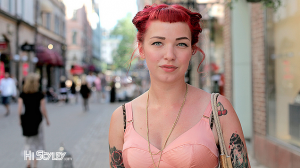All sorts of images are conjured up when we imagine the Scandinavian woman of the Viking era: a tough and robust fair-haired woman charging into battle alongside her equally robust male counterpart–horned helmets and all (even though the ‘horned-helmeted Viking’ is in fact a fallacy, but you get the idea). What then do we imagine our present-day female Norse counterparts to be? Back in the day of Viking warriors and English monasteries, the contrast between the Norse Pagan culture and the Anglo-Saxon Christian culture was stark; most notably perhaps was their differing religions; the Vikings worshipped many gods–and notably goddesses as well–whilst the Anglo-Saxons in England worshipped one male god.
Of course, the cultural differences, across Europe specifically, are less marked today, due to centuries of war, integration, trade and travel; so when I recently travelled from the UK to Sweden for a ten-day tour, I wasn’t really expecting to notice so many differences between the women of my native British culture and that of Sweden. There were however, certain elements of the Swedish woman’s place in society which particularly stood out. The first thing, albeit only a superficial characteristic but nonetheless notable, is the norm for women to have tattoos, and pretty large tattoos at that, in contrast to a certain taboo for the British woman sporting something equally eye-catching.
It is the relationship between men and women however, and both their respective places in society and together, in which I found the most cultural variation. In Sweden for example, it is absolutely the norm for a couple to have children in their early twenties, whereas in the Britain, there is certainly more age diversity amongst couples with children.
Something which somewhat shocked my typically English reserve was the Swedes’ openness and friendliness in conversing with us as strangers, (the men more than the women in fact). We were approached by a number of young men and I didn’t feel what is often perceived to be the case when strange men approach women. Instead, we all learned a lot about Swedish culture and the people we met, and not cheapened by the looming doubt of an ulterior motive. That being said, after a late-night out, we three walked back to our hostel through the dead silent city-centre of Sweden’s capital and were catcalled and approached by three different groups of men, which was not only scary, but surprising. I had always heard that Stockholm in particular was a very safe city, and up until this point, we had not experienced any negative or intimidating treatment. This however is not meant as a damning report of the alleged safety of Sweden, or of their attitude towards women, because ultimately those men are not representative of the entire male population. However I was a little disappointed that in such a forward-thinking country in so many respects, and seemingly in the social standing of the Swedish woman, I still experienced sexism, albeit only on one occasion, but nonetheless intimidating and unpleasantly surprising, which was worsened by the unfamiliar setting and the silence of the city.
-Tilly Aspbury
Junior Girl
Girl Museum Inc.

